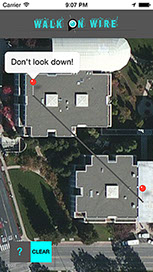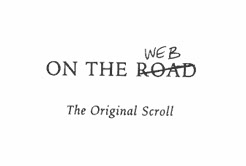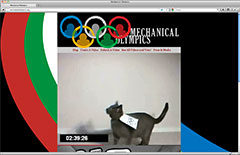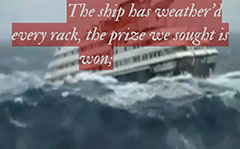
xtine is a new media artist and educator. Her projects motivate interactive audiences to understand virtual experiences as personal arenas for discovery and meaning-making.
An iPhone/iPad app that augments a user's walk to simulate the experience of walking on a high-wire. This project was made in homage to Philippe Petit's 1974 walk between the Twin Towers in NYC. Download the app or visit the project page.
Developed in XCode with Objective-C
& Submitted to the App store in July 2014
In Vigil For Some Bodies media artist xtine burrough hired virtual workers on Amazon’s Mechanical Turk website (mTurk.com) to light a candle for somebody. Instead of the digital maneuvers the elastic workforce is often tasked with performing (sorting, labeling, captioning, and so on), for this Human Intelligence Task burrough paid the Turkers for a moment of self-reflection with a gesture towards somebody loved, lost, or remembered.
As evidence of completing the job, the worker optionally submitted the name of the person remembered, and in some cases additional, supporting text. Coincidentally, this HIT was created and executed on All Hallows’ Eve (2015). Shortly thereafter, Amazon held a job fair to employ seasonal associates in Amazon Fulfillment Centers (AFCs) nation-wide. Burrough was hired in a Dallas-area AFC where she created an artificial candlelight vigil for many of the unknown and disembodied, virtual workers. The displays included LED battery operated candles purchased on Amazon.com, modified with transparent labels.
Created in collaboration with crowd workers on Amazon.com's Mechanical Turk (mturk.com) website.
Though I did apply for a job at Amazon in order to capture this series of images, I also resigned before working as no cameras or phones were allowed in the Fulfillment center.
Mediations on Digital Labor began with a hijacking of the Amazon.com Mechanical Turk website (Murk.com) for a critical, poetic, and alternative practice: Artist xtine burrough hired the Turkers to pause from physical labor, to share their thoughts on resting, and to chant “Om” for 10 seconds. Demonstrating the tension between play and labor, this collection of digital chants, compiled from a virtual job board, showcases the voices of disembodied strangers making a sound that can accompany one’s return to her body at a vibrational frequency found throughout the natural world. In the gallery participants are invited to work, rewriting in chalk on the floor of the space the various Turker thoughts on resting, and are awarded with one of the USB drives hanging from the wall. Each one contains a chant.
Mediations on Digital Labor exhibited in the Project Room at Grand Central Art Center, Santa Ana, CA from May-July 2015.
For his review in OC Weekly, Dave Barton explained the floor of the exhibit: "The now ephemeral quality of work (and lack of security that comes with it) reveals itself on the installation itself. Patrons have to interact with the misery of the workers represented: If they want to read what has been written, they have to stand on other words to do so. Those words—and the work represented by those words—slowly becomes an indecipherable blur of white chalk dust after enough people have shuffled through it."
On The Web is a translation of Jack Kerouac’s 1957 classic, On The Road for the modern web browser. In this interpretation of the novel every appearance of the word, “road” was crossed out and replaced in my copy of the novel with the word, “web” to investigate whether modern life and web surfing are reflected in the original road-trip manuscript. In many cases, the work still speaks to wanderers browsing the information superhighway or hitchhiking on the open road. Each page was scanned and uploaded into a design mirroring the format of Kerouac's original scroll, made with contemporary code.
Developed in HTML5/CSS 3
On The Web is part of the Browser Poem series created with the support of a Terminal net.art commission in 2011.
On The Web placed 2nd in the
2012 AEJMC Best of the Web competition.
The Mechanical Olympics are a crowdsourced competition of athletic performances that reinterpret the Olympic Games as a series of amateur, hobbyist videos that can be funny, poetic, or banal. Participants are invited to play on Amazon.com’s Mechanical Turk virtual job board. Voting for gold medal winners is as simple as pressing the “Like” button on your favorite YouTube Mechanical Olympics videos during the commencement of the Olympic Games. Top videos win an award. Anyone can participate in future Mechanical Olympics games by uploading a video to YouTube and sharing it on the Submit page.
Mechanical Olympics is a 2009 Honoree of the Webby Awards.
It was presented as the Mechanical Games at Abandon Normal Devices (Manchester, UK 2010) and Looping the Loop (Media City, UK 2012).
Mechanical Olympics is the subject of a chapter I wrote for my edited collection, Net Works: Case Studies in Web Art & Design
Mechanical Olympics [PROMO VID]
In 2011 I received a Terminal commission to create a series of three Browser Poems. For this project, I translated three works of literature into user-experiences for the web browser. O Browser, My Browser is one of these browser translations based on Walt Whitman’s turn of the century poem, O Captain, My Captain. In this design of the poem, each line is represented by selected YouTube videos based on a keyword search. The poem is dissected line by line and resurrected into a series of linked public videos from the global community publishing on YouTube.
Developed in HTML5, this project was created with
the support of a 2011 Terminal net.art commission.

Library of Congress, Remixed prints are 9 by 12 inches on Arches paper. Digital negatives were made using Pictorico’s fine transparency film.
The Library of Congress, Remixed is a series of cyanotype collages that synthesize digital search and imaging processes with cyanotype, a traditional printing method recognizable by its deep blue hue. The US Library of Congress photo archive, made easily searchable on Flickr.com, is remixed in photographic collages where keywords from common English idioms are juxtaposed to form a single visual message. For instance, an idiom such as “the sky is the limit” is reconstructed as a visual message based on an image search for the key words “sky” and “limit” in the LOC. The collages show a spectrum of meaning-making from absurdity to lucidity.
Library of Congress, Remixed
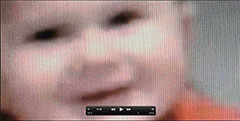
Let’s Go Crazy is the subject of an article and book chapter I co-authored with Dr. Emily Erickson for the Journal of Interactive Technology and Pedagogy and the Routledge Companion to Remix Studies.
Let's Go Crazy Playlist
Let’s Go Crazy encouraged students to examine the Lenz v. Universal case as a unique vehicle to learn about fair use and the creative transformation of copyrighted content. The Lenz case highlights a gap between First Amendment rights found within fair use doctrine and current practices under the Digital Millennium Copyright Act. What Lawrence Lessig calls today’s “remix culture” makes it imperative to provide students with a strong grounding in both copyright and fair use, as well as a savvy understanding of how copyright owners are approaching unauthorized uses of online content. For the project, students created their own video remixes and responses to Stephanie Lenz’s original video, “Let’s Go Crazy #1” and posted them on the YouTube video response page—a part of the YouTube interface that is, coincidentally, no longer available.
Let's Go Crazy

I developed the Delocator website in 2005 so users could locate and contribute to an online database of independently owned cafés. The Delocator is the opposite of an online retail store locator—a common web interface on corporate store websites. Originally launched with the assistance of 2005 AiOC multimedia student, and programmer extraordinaire Vasna Sdeoung, this website has been redesigned four times since its launch. Tom Brickman, a web developer from the UK, voluntarily redesigned the site and added a map to its front page in 2013.
Delocator Project
Delocator.net was widely reviewed in domestic and international media outlets around the time it was launched (spring 2005-2006). See the project website for a selected list of stories, books, radio shows, and a documentary film. I wrote extensively about the Delocator for the Journal M/C.
Pretty much everything here is copyleft: xtine burrough CC-BY-NC-SA
